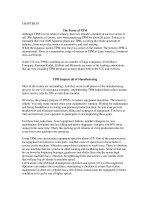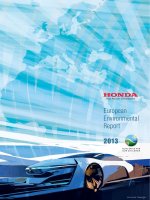honda the power of dreams honda environmental annual report 2011
Bạn đang xem bản rút gọn của tài liệu. Xem và tải ngay bản đầy đủ của tài liệu tại đây (6.15 MB, 54 trang )
Honda
取り組み事例集と補足情報
2 0 11
EnvironmEntal
annual rEport
2-1-1 Minami Aoyama, Minato-ku
Tokyo 107-8556, Japan
Honda Motor Co., Ltd.
Case Studies and
Supplementary Information
51
Honda global environmental symbol
and slogan
Our goal under the Honda Environmental Vision is
to leave the joy and freedom of mobility for future
generations (for our children). That is why we must
create a sustainable society where people can enjoy
life (blue skies). These aspirations are symbolized in
our environmental slogan and symbol.
Production company (Japanese and English versions)
SHIAN INC., Tokyo, Japan
Publisher
Environment & Safety Planning Oce
Manager
Michio Shinohara
Editors
Hisashi Kato, Fumie Kimijma, Shunsuke Kawasaki
Persons responsible
Sales and services
Automobile Shigeaki Kato
Yasumasa Shimizu
Motorcycle Masaharu Iuchi
Power Products Takaoki Watanabe
Service and Parts Noriya Kaihara
Recycle Promotion Oce Hideaki Kobayashi
Purchasing Akifumi Suganuma
Factory and oce operations environmental administrators
Saitama Factory Shigeo Ono
Tochigi Factory Koichi Aonami
Hamamatsu Factory Masamichi Matsumura
Suzuka Factory Masaomi Ajioka
Kumamoto Factory Takayoshi Fukai
Automobile New Model Center Hiroyuki Yoshihara
Quality Innovation Center Tochigi Yukihiro Kariya
Head Oce Takao Aoki
Honda R&D Co., Ltd.
Automobile R&D Center (Wako)/
Fundamental Technology Research Center/
Aircraft Engine R&D Center Akio Yagasaki
Motorcycle R&D Center/Power Products R&D Center
Fumihiko Nakamura
Automobile R&D Center (Tochigi) Jun Yanada
Automobile R&D Center (Takasu Proving Ground)
Koji Kawai
Honda Engineering Co., Ltd Masuhiro Sakurai
Logistics
Products and service parts sets Toshihide Nakai
Administration
Administration Takao Aoki
Personnel Tetsuya Tsutsui
Corporate Communications Masaya Nagai
Intellectual Property Yuichiro Kawamura
Note: Current as of June 1, 2011.
Please direct enquiries to:
● Environment & Safety Planning Office
Tel: +81-(0)3-5412-1155
Fax: +81-(0)3-5412-1154
This report can also be found on the
Honda Worldwide website:
index.html?id=6
Environmental information disclosure
The Honda Environmental Annual Report is published yearly. It presents environmental corporate information,
including Honda’s policies and future direction with respect to the environment. The report focuses particularly on
the results of the year’s initiatives in each management domain, and on progress made toward targets from the
point of view of Honda's corporate activities throughout its products’ life cycles. Complementing the disclosure of
environmental corporate information, Honda’s website ( />html) provides further details about the results in each domain (for instance, environmental impact
data for each Honda facility), and also presents the history of Honda's environmental initiatives.
By disclosing a wide range of information, we hope to facilitate communication and feedback,
thereby strengthening our environmental conservation initiatives going forward.
Environmental annual report
The Honda Environmental Report is comprised of two parts: the Main
Report, which focuses on annual environmental initiatives, and the
Case Studies and Supplementary Information, available exclusively on
Honda’s web site, which covers specific initiatives in each of the
domains introduced in the report.
The Honda Worldwide website’s
environment section
environment/index.html
Information focusing on annual initiatives Comprehensive environmental information
Editorial policy for the Honda Environmental Annual Report
Early in its history, Honda recognized that an involvement in eorts to combat various kinds of environmental problems was one of its
most important management priorities. We publish the Honda Environmental Annual Report to inform the public about our environmental
initiatives over the preceding year. This is the 14th edition of the Honda Environmental Annual Report, which was rst published in 1988.
As of 2011, Honda regards global climate change and energy issues as being particularly important among the many
environmental problems that exist today. (see Page 6 for details.) To combat these problems, Honda is working to reduce
emissions of greenhouse gases resulting from its business activities and from the use of its products, and has set medium-term
targets for this purpose (see Page 8). Under our mid-term management plan, we have also formulated and are steadily
implementing environmental initiatives to combat other environmental problems (see Page 10).
We will continue to inform the public about these initiatives, and in particular about the progress we have made each year,
through the Honda Environmental Annual Report. Other information, including details and data, are regularly posted on our
website, as indicated in Disclosure of Honda Environmental Information.
Other key information disclosure
Honda’s environmental reports and website also contain corporate information other than that concerning the environment.
Honda is continuously working to enhance communication with its stakeholders by making information about its various
activities easy to understand and encourages feedback. Honda regards full communication with all stakeholders as essential to
further improving its activities, and welcomes feedback to this and all of the reports listed below.
V CSR
Information
Presents Honda’s ideas on Corporate Social Responsibility (CSR), and its
initiatives in the areas of quality and safety, environment and society.
CSR website:
CSR report: />V Investor
Information
Presents information on Honda’s business performance.
Investor information:
Annual report: />V Information on
Philanthropic
Activities
Presents the ideas behind Honda’s philanthropic activities,
and its main initiatives.
Social activities website: />V Safety
Information
Presents Honda’s safety initiatives from two perspectives: activities aimed at
promoting product safety and those aimed at promoting trac safety.
Safety activities:
Driving safety promotion activities:
(This URL is Japanese only)
Report on driving safety promotion activities:
(This URL is Japanese only)
Online
Case
Studies and
Supplementary
Information
Main
report
CONTENTS
Honda Group case studies
Initiatives in Japan
04 Adding 2.4MW capacity thin-lm solar panels at business sites in Japan
HomePowerGenerationBusinessPlanningOce
HondaMotorCo.,Ltd.
07 CO
2
emissions reduced by approximately 1,400 tons through thermal recycling
and the development of a smaller VOC treatment facility
PlasticDepartment,SaitamaFactory,HondaMotorCo.,Ltd.
11 VOCs reduced by 50% through the use of water-based base coatings and
special coatings for inner panels
Paint&PlasticDepartment,SuzukaFactory,HondaMotor,Co.,Ltd.
16 New treatment facilities deliver best wastewater quality in the industry
FacilitiesDepartment,SuzukaFactory,HondaMotorCo.,Ltd
20 Eco-responsible initiatives combined to create advanced Green Factory
BusinessAdministrationDivision,FacilitiesControlDepartment,
HamamatsuFactory,HondaMotorCo.,Ltd.
25 Cutting CO
2
by 21% through a modal shift
ProductionOperations,ProductionPlanning&LogisticsDivision,
HondaMotor,Co.,Ltd.
28 2010 Honda Green Conference
HondaMotor,Co.,Ltd.
32 CO
2
emissions reduced by 30% through installation of a gas heat pump
HondaMotorCo.,Ltd.,AdministrationDivision,
RealEstateManagementDepartment
KyowaSogoManagementCo.,Ltd.
ShinryoCorporation
HokkaidoGasCo.,Ltd.,R&DCenter
HokkaidoUniversity,GraduateSchoolofEngineering,Laboratory
ofBuildingEnvironment
36 Reducing CO
2
emissions through a water cycle framework
KanetaKogyoCo.,Ltd.
40 Product development
41 Product recycling (reduce, reuse, recycle)
43 Administration
Additional information
44 Automobile environmental performance information (Japan)
45 Motorcycle environmental performance information (Japan)
46 Power products environmental performance information (Japan)
47 Japan facilities information
1
Advancing operations in regions
6
656,000
1,241,000
608,000
190,000
372,000
398,000
15,011,000
1,682,000
273,000
256,000
1,243,000
Europe/Middle
East/Africa
China
Japan
Asia/
Oceania
Automobiles Motorcycles Power products
and other
0
50,000
100,000
150,000
(¥ billion) ■ Unconsolidated ■ Consolidated
2007 2008 2009 2010 2011
(FY)
-2,000
2,000
6,000
10,000
0
8,000
4,000
■ Unconsolidated ■ Consolidated
(FY)
(¥ billion)
2007 2008 2009 2010 2011
-1,000
5,000
4,000
7,000
0
6,000
1,000
2,000
3,000
■ Unconsolidated ■ Consolidated
(FY)
(¥ billion)
2007 2008 2009 2010 2011
Driven by its philosophy of building products close to the customer, Honda has manufacturing operations in six re-
gions worldwide. In FY2011, Honda delivered 27 million products to its customers around the world. Always con-
scious of the environmental impact of its operations, Honda is working hard to take environmental
responsibility to ever higher levels around the world.
In 2006, Honda announced global CO
2
emissions reduction targets for 2010, the rst announcement of its type
by a company in the automobile industry. In 2011, we adopted “the Joy and Freedom of Mobility” and “a Sustain-
able Society where People Can Enjoy Life” as the Honda Environmental Vision. Under this vision, Honda is deter-
mined to accelerate its global eorts to nd solutions to climate change and the energy problem.
Annual sales in Honda’s six regions
by unit volume (FY2011)
Power products:
included in gure for
Asia/Oceania
Net sales Operating income Net income
Financial information
2
3
1,465,000
2,094,000
184,000
159,000
1,744,000
118,000
0
50,000
100,000
200,000
150,000
2007 2008 2009 2010 2011
■ Unconsolidated ■ Consolidated
(FY)
Number of associates Net sales by operational area
(consolidated: FY2011)
Net sales by region
(consolidated: FY2011)
Company name: Honda Motor Co., Ltd.
Head oce: 2-1-1 Minami Aoyama, Minato-ku
Tokyo 107–8556, Japan
Established: September 24, 1948
President & CEO: Takanobu Ito
Capital: ¥86.067 billion
(as of March 31, 2011)
Sales: Consolidated: ¥8.9368 trillion
(Results of FY2011)
Unconsolidated: ¥2.9154 trillion
Number of associates: Consolidated: 179,060
(as of March 31, 2011)
Unconsolidated: 25,673 (as of March 31, 2011)
Consolidated subsidiaries:
383 (as of March 31, 2011)
Major products:
Automobiles: Standard-sized vehicles, compact
vehicles and mini-vehicles
Motorcycles: Scooters, mini-bikes, motorcycles,
ATVs and personal watercraft
Power products: Power product engines, lawnmowers,
marine outboard engines, CIG thin
lm solar cells, and household gas-
engine cogeneration units
Note: Honda is a member of the World Business Council for
Sustainable Development (WBCSD).
Company overview
Automobiles
76.0%
Financial services
6.3%
Power products
and other
3.3%
Motorcycles
14.4%
Japan
16.8%
Europe
6.8%
Asia
20.7%
North
America
43.9%
Other
11.8%
North
America
South
America
2
3
Honda Group case studies
1
From creating products that people
use everyday to the energy
production business
2
19,000 panels installed at
15 sites in one year
Home Power Generation Business
Planning Oce,
Power Products Operations Division,
Honda Motor Co., Ltd.
General Manager Omura
Thin-lm solar panels at the Hamamatsu Factory
In scal 2010, Honda installed thin-lm solar panels with a total capacity
of 2.4MW at 15 major business facilities in Japan. Together with panels
previously installed, this brought the total capacity to 3.2MW. We
interviewed Eiichi Omura, head of the Home Power Generation Business
Planning Office in the Power Products Operations Division, which has
coordinated the implementation of this project, about the reasons for
Honda’s decision to install solar panels at its main business facilities.
Adding 2.4MW capacity thin-lm solar panels
at business facilities in Japan
4
5
3
Honda CIGS thin-lm solar panels
aim to be the best in the world
A solar cell module
Honda Soltec solar panels
at the Hanshin Koshien Stadium
Kumamoto Prefectural Oce
(installation completed in February 2010)
4
5
4
A commitment to original technology
5
The Honda Smart Home concept
—produce at home, use at home
Experimental cars at a solar charging station
6 7
Honda Group case studies
At the Saitama Factory, Honda has installed regenerative thermal oxidizers
(RTOs)
1
on its bumper coating line to reduce emissions of volatile organic
compounds (VOCs). The RTOs enabled VOC concentrations to be reduced
below the required standard while also reducing energy requirements
through heat recovery, without changing the existing facilities. We also
succeeded in reducing the size of RTOs after discovering the leveling
eect of activated charcoal on VOC concentrations. These measures have
reduced CO
2
emissions by about 1,400 tons annually.
1
Improving processes
without changing existing facilities
2
Minimizing energy used by RTOs
Plastic Department, Saitama Factory,
Honda Motor Co., Ltd.
The VOC treatment facility at the Saitama Factory
CO
2
emissions reduced by approximately 1,400 tons through thermal recycling
and the development of a smaller VOC treatment facility
Masahiro Nakao
Hisashi Saito
6 7
A bumper coating booth
3
Heat from RTO utilized in
two thermal recycling pathways
Structure of a Regenerative Thermal Oxidizer (RTO)
Regenerative Thermal Oxidizer (RTO):
This is a generic term for a system that accumulates heat while
breaking down gases through combustion.
* The RTO can be fueled by LNG or VOCs.
Burners
Gas burner
Oil burner
Poppet damper
Heavily shielded,
durable, easy to maintain
Thermal insulation
support grid
Input/output
ducts
Incinerator
VOCs and aromatics
broken down at
high temperatures
(800ºC or higher)
Honeycomb ceramic heat
absorption material
・ Large contact area̶
high heat exchange efficiency
・ Direct gas flow̶pressure loss reduced
Thermal insulation
250mm thick̶This
reduces thermal radia-
tion and keeps the
surface temperature of
the system low.
Hot bypass
damper
This efficiently uses
thermal energy from the
spontaneous combus-
tion of hot VOCs.
Cleaned air is carried through this recycling duct.
Burners fueled by LNG in the air-conditioning chamber
8
9
4
Leveling eect of activated
charcoal discovered during trials
5
Leveling eect of activated charcoal used
to raise concentration levels, reduce the
size of the RTO, and turn VOCs into fuel
Structure of the VOC treatment system
Filter unit
removal of
coating mist
Heat exchanger
humidity
adjustment
Coating booth
Bumper coating
line air conditioner
Thermal recycling duct
RTO exhaust
Adsorption
air
Hot bypass
Cleaned air
RTO
(regenerative thermal oxidizer)
Activated charcoal
removal of solvents with
high boiling points
Concentration system
concentration of VOCs
RTO
breakdown of
VOCs through
oxidation
Module Manager Shinichi Araki
(in charge of project implementation)
Factory Manager Shigeo Ono
(overall project supervisor)
8
9
6
Refusal to accept waste reduces
CO
2
emissions by around 1,400 tons
Checking Concentration Levels
0
200
400
600
800
1,000
1,200
(ppmC)
0
200
400
600
800
1,000
1,200
(ppmC)
Time →Time →
3,414
2,278
1,709
2,276
0
500
1,000
1,500
2,000
2,500
3,000
3,500
(ppm)
VOC concentration in bumper coating exhaust gas
General Design
VOC concentration (toluene equivalent)
after concentration and conversion to fuel
Below1/4 of explosion limit concentration
(equivalent to 3,175ppm of toluene)
Within explosion limit
concentration standard
Design incorporating the leveling effect
of activated charcoal
VOC concentration after exhaust gas has
passed through activated charcoal
Outside
standard
Within
standard
Within
standard
Within
standard
RTO design value
RTO design value
Without activated
charcoal: 10 times
Without activated
charcoal: 15 times
With activated
charcoal: 15 times
With activated
charcoal: 20 times
RTO size reduced
by 30%
LNG consumption reduced by 30%
Air consumption reduced by 35%
Natural ratio: 80%
Hisashi Saito and Masahiro Nakao
10 11
Honda Group case studies
1
Gradual conversion of No. 3 line
in new coating plant
2
Drying ovens eliminated to
create 4C2B line
Shinji Yamamoto
In the Suzuka Factory’s new coating plant, Honda has created a coating
line that is shorter than normal. It has also halved the amount of volatile
organic compounds (VOCs) emitted per unit of production by using
water-based base coatings, using special coatings for inner panels, and
automating the coating of inner panels. Honda’s approach to the challenge
of reducing VOC and CO
2
emissions began with the development of
specialized coatings.
VOCs halved by 50% through the using water-based
base coatings and special coatings for inner panels
Paint & Plastic Department,
Suzuka Factory,
Honda Motor, Co., Ltd.
10 11
3
Achieving full automation
of inner panel coating
Changes to the coating process
Middle
coat
Base
coat
Clear
coat
Drying oven
Drying oven
F/O
F/O
Electrodeposition
Preprocessing
UBC
Polishing/
cleaning
Polishing/
cleaning
Jig
attachment
Inspection/
polishing
Storage
F/O
F/O
Solvent
Water-based Water-based Water-based
4C3B Process
4C2B Process
Jig
attachment
Preprocessing
Drying oven Drying oven
Storage Storage
Middle
coat
Drying oven
Drying oven
UBC
Polishing/
cleaning
Storage
Water-based Water-based
Electrodeposition
Solvent Solvent
Base
coat
Clear
coat
Inspection/
polishing
Drying oven
Storage
VOC emissions (FY2008)
Base:
63%
Clear:
15%
Middle coat:
9%
Electrodeposition:
7%
Others:
6%
Per unit:
40.0g/m
2
Masahiko Onishi
Key
12
13
4
Color-coding technology for
inner panels made possible by
innovative arrangement of coatings
Composition of coatings on automobile bodies (four coats)
Steel panel
Electrodeposition
Middle coat
(solvent-based)
Base coat (water-based)
Clear coat (solvent-based)
The new 4C2B coating line
The new building completed in May 2009
12
13
5
Amount of coating reduced through
opacity improvement
Whywouldtheuseofspecializedbasecoatingsoninnerpanelsreduce
the amount of coatingsused?One of thepropertiesofacoatingis
opacity
3
.Iftheopacityofacoatingisweak,thesurfacelayerwill
showthrough.Forthisreason,coatingsmustbeappliedwithacertain
thicknessevenon inner panels, whichhave complex shapes.“Even
oninnerpanels,weformulatecoatingstopreventthesurfacefrom
showingthroughbyadjustingthepercentagesandparticlesizesof
lustrousmaterials(metallicpigments)”saysMr.Onishi.“Thisallowsusto
achieveopacityevenwiththincoatings,whichmeansthattheamounts
ofcoatingsusedcanbe reduced.”Thiswasthersttimeintheworld
thatspecializedbasecoatingswereusedoninnerpanelstoreducethe
amountofcoatingsapplied,withoutanyeectonproductattractiveness.
Thenewmethodalsoimprovedthequalityofthenishedresult.
ThefacilitiesattheSuzukaFactoryarecapableofcolorcodinginup
to16colors,ofwhich10areusedexclusivelyoninnerpanels.Byusing
specializedcoatingsoninnerpanels,Hondacouldreducetheamountof
coatingsusedby32tonsperyearandemissionsofVOCscontainedin
thosecoatingsbyapproximately2.5tons.
3Opacityisacolorpropertythatpreventsthesurfacelayerfromshowingthroughcoatings.
Noritoshi Gouda
High opacity
置換
Rearrangement
Pearl
pigment
Organic
pigment
Aluminum
Inorganic
pigment
Changes in pigment composition
(opacity enhancement)
Specications for inner panel coating supply system
Coated outer
panels
Coated inner
panels
Specialized inner-panel coatings
Exterior panel coatings
Additional
facilities
Specifications
for new plant
14
15
6
Water-based paints in use at the
Suzuka Factory since 2000
7
VOC emissions reduced by about 50%,
emission concentrations down to 187 ppmC
Coatings are prepared in the mixing room.
From left: Onishi, Yamamoto, Gouda
Left: Outer panel coating, right: Inner panel coating
40g/㎡
Base
coating
25.2
30g/㎡
10g/㎡
20g/㎡
Others
Before
Clear
coating
6.0
6.0
Middle
coating
3.6
Electrodeposition
2.8
Water-based
base
coating
Coating efficiency
improvement
After VOC countermeasures
4.68
2.95
Inner panel
coatings
6.44
2.53
2K middle
coating
Electrodeposition
Clear
coating
Others
Base
coating
4.35
0.14g/m
2
40.0g/m
2
20.95g/m
2
Target: 21g/m
2
VOC emissions per unit (actual)
14
15
Honda Group case studies
Wastewater treatment facilities at the Suzuka Factory were replaced
in 2010. By adopting an orthodox approach based mainly on biological
treatment, we were able to minimize costs while achieving the highest
treatment quality in the motor vehicle industry. The new system can also
treat wastewater from the new line in the coating plant, which is now
using water-based paints as base coatings.
1
Wastewater from the Suzuka Factory
enters Ise Bay
2
Capacity to treat wastewater
from the new water-based coating line
Facilities Department, Suzuka Factory
Honda Motor Co., Ltd.
New treatment facilities deliver
best wastewater quality in the industry
The new wastewater treatment facilities are in line,
eliminating need for underground work.
Ken Shiotani
16
17
Water-basedproductshavebeenusedformiddleandbasecoatings
ontheNo.1CoatingLineattheSuzukaFactorysince2000,whichmeans
thatwater-basedpaintswerealreadybeingsprocessedintheoldsystem.
However,atthattime,mostofthecoatingswerestillbasedonorganic
solvents.ThenewNo.3CoatingLine,inoperationsince2009,hasbeen
progressivelyconvertedtotheuseofwater-basedproducts,whichnow
makeup80%ofthecoatingmaterialsinwastewaterfromthecoating
plant.Severaltreatmentprocesseswereconsidered,buteventuallyit
wasdecidedtouseanorthodoxbiologicaltreatmentmethod,which
isrelativelycheaptooperate.Tomeetthestringentenvironmental
standards,anewtertiarytreatmentfacilitywasalsoinstalled.
3
The concept: wastewater treated to the same
standard as industrial water, consistently and reliably
Thegoaloftheprojectwastocreateasystemthatwouldconsistently
andreliably treat allwastewater treatedandreleasedlocallytothe
samestandardasindustrialwater,therebyensuringlowenvironmental
loadsattheSuzukaPlant.Inadditiontoraising thequalityoftreated
water,Hondaalsowantedtoimprovemaintainability,prohibithazardous
processes,andlimittheamountofwasteproduced.
InJune2007, thegovernmentofMiePrefectureissueda notice
requiringnewlybuilttreatmentfacilitiestomeetatotalpollutant
standardofchemicaloxygendemand(COD)
1
of10mg/liter.In2006,the
oldfacilityhadawastewaterCODlevelof40mg/liter.Honda’sgoalwas
toreducethisto7mg/liter,whichwouldbelessthanone-quarterofthe
oldlevelandamongthebestinthemotorvehicleindustry.
WastewaterfromtheSuzukaFactoryincludesoil-bearingwastewater,
whichcontainscuttingoilfrommechanicalprocessingequipment;coating
wastewaterfromthecoatingplant;generalwastewater,suchasdomestic
wastewaterfromkitchensandtoilets,andrainwater.HiroshiSano,an
engineerwiththeFacilitiesDepartment,recallsthatthereusedtobe
separatetreatmentfacilitiesforwastewaterfrommechanicalprocessing
equipmentandthecoatingplant.“Thetreatmentfacilityforcoating
Hiroshi Sano
Treatment paths in upgraded wastewater treatment facilities
Wastewater treatment plant
control building
Coating wastewater
treatment facility
Oil-bearing wastewater
treatment facility
Tertiary wastewater
treatment facility
Circular oil separation tank
Oil-bearing
wastewater
Coating
wastewater
Coating wastewater
intake tank
Process wastewater
outflow
Processed wastewater
Emergency
water tank
Secondary wastewater
treatment facility
Blower room
Coating wastewater path
Oil-bearing wastewater path
Processed wastewater path
(combined coating and oil-bearing wastewater)
Coating wastewater and
oil-bearing wastewater combined in
secondary treatment facility
Hiroaki Kubo
16
17
4
Treatment facilities based primarily
on biological treatment
A panel display in the wastewater treatment plant
showing the wastewater treatment process.
Treated wastewater ows into a small stream created
within the factory grounds.
Flowchart of the upgraded treatment facilities
反応槽 疑集槽
Production wastewater
Domestic wastewater
To Suzuka River
Process
wastewater
Industrial
wastewater
General
wastewater
Reaction
vessel
Reaction
vessel
Reaction
vessel
Oil-bearing
Electrodeposition
Filming
Preprocessing
Domestic
waste
Anaerobic
vessel
Neutralization
vessel
Flocculation
vessel
Flocculation
vessel
Aeration
vessel
Aeration vessel Settlement
vessel
Sand
ltration
Neutralization
vessel
Subject to total pollutant regulations
Flocculation
vessel
Membrane
separation
vessel
Activated charcoal
adsorption
Pressurization
vessel
Pressurization
vessel
Flocculation
vessel
Settlement
vessel
Secondary treatment Secondary treatment
System A
System A
System B
System B
System C
Primary treatment
18
19
5
Original and simple design—emphasizing
ease of maintenance and management
6
Types of substances reduced to one-third,
CO
2
emissions cut by 45 tons per year
The central monitoring system in the operations room
The inside of a circular oil separation vessel,
located above-ground
From left: Shiotani, Kubo, Sano, Mukai
Kiyomitsu Mukai
18
19
Honda Group case studies
The Hamamatsu Factory has been transformed into a powerhouse
of automobile production. Located in the middle of the Aoi Plant,
this advanced environmentally responsible factory was completed in
September 2010. Features include rooftop gardens and the biggest solar
power system at any Honda factory. The factory is also equipped with
the world’s most ecient air supply system, thanks to the installation of
a new compressor in time for the opening of the new facility. As a result,
Hamamatsu won the compressor efficiency award at the Honda Green
Conference in December 2010.
Eco-responsible initiatives combined to
create advanced Green Factory
1
New environmentally responsible
automobile transmission factory
2
New approach to air supply system
design—emphasis on usability
Business Administration Division
Facilities Control Department
Hamamatsu Factory
Honda Motor Co., Ltd.
Masamichi Matsumura
Hamamatsu Factory
Tetsuji Fujiwara
20
21
Eco-responsible initiatives combined to
create advanced Green Factory
3
The goal: to make the world’s
most ecient compressor system
Tatsuo Toki
A highly ecient large-capacity IGV turbo compressor
Air supply eciency
How much air can be
supplied for 1KWh
of electricity?
Targets
Before
changes
After
changes
Benet
9.0
20
21
4
Automatic control system combining
screw and turbo compressors
5
From supply-side control to
demand-side control of pressure
A control system in the central monitoring room
for electrical equipment
Super-ecient system based on optimal mix
of screw and turbo compressors
Inverter screw compressor
Rotor speed adjusted
by inverter
IGV turbo compressor
Opening adjusted by inlet guide
vane suction valve
Capacity
adjustment
range
20% Rated
Air
volume
Efficiency
difference:
1.0 or more
Air supply
efficiency
(Nm
3
/KWh)
Air supply
efficiency
target
80% Rated
7.0
10.0
8.0
9.0
10.0
8.0
9.0
7.0
10.0
8.0
9.0
Capacity adjustment range
10,000 20,000 30,000 40,000
(Nm
3
/h)
More units
① Screw
② Turbo
Comparison to a car:
}
Optimal
control
Supercharger for low revolutions
Turbocharger for high revolutions
Super-ecient system based on preferential operation for
① low loads and ② high loads
Zero oil use
22
23
6
Potential to reduce CO
2
emissions
by 10,000 tons by using this technology
in Japan and overseas
7
Matching the height of Mount Fuji
with 3,776 thin-lm solar panels
A solar power system has been installed on the roofs
and walls of the new factory.
Presenting the technology
at the 2010 Honda Green Conference
Layout of the demand-side pressure control system
E-2
compressor
room
General-purpose
power building
22
23









